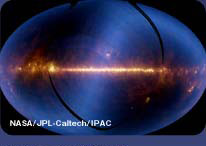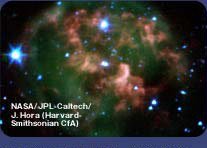|
 |
 |
 |
 |
 |
 |

You can see the past by looking into the far distance in space. The farther you look, the more infrared rays can show you how galaxies were formed and when stars were born. Infrared exploration can take us deep into the history of space. It allows us to study the formation of galaxies and stars after the Big Bang, and the workings of the current space environment. The problem, however, is that it is difficult to draw broad conclusions about the behavior of galaxies by looking at just a few of them, as there are an uncountable number of galaxies in the universe. So the more data we can collect and compare, the closer we can get to deciphering the mechanisms of space evolution. An infrared telescope is an essential instrument for this kind of close observation of distant objects. |
 |


A look at space evolution
The farther the celestial body is from Earth, the farther it is in the past
 |
 |
 |

Twenty years ago, IRAS maps allowed us to make many discoveries. But once you have an image of the entire universe, eventually you want to zero in on some of the more peculiar or interesting environments. Although the United States and Europe had planned to build infrared astronomical satellites to study individual celestial bodies in detail, all the countries ran into budget problems. It was not until ten years after IRAS that the European Space Agency (ESA) finally launched ISO. And when America's Spitzer Space Telescope (SST) was finally launched in 2003, twenty years after the project was conceived, it was much smaller than originally planned. This means that the first data is more than 20 years old, and the original space maps are out of date. Under these circumstances, Japan decided to develop Akari to perform an All Sky Survey and produce new space maps. Astronomers around the world are eager for Akari data, which will help them unveil more mysteries of the universe.
 |
 |
 |
 |
| IRAS(1983) |
ISO(1995) |
SST(2003) |
Akari(2006) |
 |
 |


IRAS map
 |
 |
 |

Scientists have been studying stars for a very long time, and had thought that they had gained a good understanding of them when the theory of the structure of stars was introduced. The fact is, however, that there are still many mysteries for us to unravel. Using Akari, we hope to find brand new stars that will allow us to study the dynamics of star formation.
The genesis of a new star actually lies in the death of an old one. When a star expires, there is no big explosion. After the hydrogen has burned out, the remaining helium expands and the star becomes a red giant. The red giant's helium burns out, and at last, after its outer gas is blown out, only the core of carbon and oxygen is left, and gradually cools off. This is how most stars end. When the gas has emitted and cooled off, dust is formed, which is very bright in the infrared. This gas emission eventually transforms into a new star. We do not yet have a clear understanding of this process, so we would like to learn more about the conditions during the birth of stars, and also during their death. We can assume that stars are not formed on a regular basis, but that there are times when a great number of stars are born at once. We hope to use data from Akari to unveil this history of space formation. |
 |
 
Birth of a star, captured by SST (NGC 1333)


End of a star, captured by SST (NGC 246)
 |
 |

 |
|



